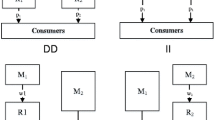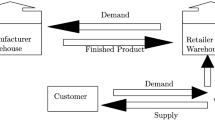Abstract
Substantial research literature has been developed over the years on the subject of inventory. The more recent literature has examined the fundamental relationships between inventory control and price theory. A significant portion of this literature assumes the ultimate consumer demand as a constant and characterizes the relationship between a manufacturer and a retailer as a leader-follower problem. A primary assumption in these studies is that the manufacturer, as the leader, exerts almost complete control over the behavior of the retailer. However, in practice, the retailer does exert some control over the manufacturer. This paper develops a framework that integrates inventory control with constant demand and the economic relationship between consumer demand and retail price. Within this framework, the impact of order quantity, wholesale price and retail price on the behavior of both the manufacturer and the retailer is investigated. Furthermore, this paper explores the issues and conclusions that results from coordinating the relationship between the manufacturer and the retailer. Our analyses demonstrate that channel coordination can be achieved by utilizing well-known bargaining models. A numerical example is provided to illustrate our theoretical findings.
Similar content being viewed by others
References
A. Banerjee, A joint economic-lot-size model for purchaser and vendor, Decision Science 17 (1986) 292–311.
E.S. Buffa and J.G. Miller,Production-Inventory Systems Planning and Control, 3rd ed., Richard D. Irwin, Homewood, IL. 1979.
A.K. Chakravarty and G.E. Martin, An optimal joint buyer-seller discount pricing model, Computers and Operations Research 15(1988)271–281.
A. Charnes, Z.M. Huang and V. Mahajan, Franchising coordination with brand name consideration, Research in Marketing 12(1995)1–47.
A. Charnes, Z.M. Huang, J.J. Rousseau and R. Armstrong, Vector extremal systems in crossconstrained games of regulatory policy analysis and synthesis, Journal of Economic Behavior and Organization 21(1993)331–347.
A. Charnes, Z.M. Huang, J.J. Rousseau and Q.L. Wei, Cone extremal solutions of multi-payoff games with cross-constrained strategy sets, Optimization 21(1990)51–69.
W.C. Chiang, J. Fitzsimmons, Z.M. Huang and S.X. Li, A game-theoretic approach to quantity discount problems, Decision Sciences 25(1994)153–168.
R.J. Dolan, A normative model of industrial buyer response to quantity discounts, in:Research Frontiers in Marketing: Dialogues and Directions, S.C. Jain, ed., American Marketing Association, Chicago, 1978, pp. 121–125.
M. Etgar, An empirical analysis of the motivations for the development of centrally coordinated vertical marketing systems. The case of the Property and Casualty Insurance Company, unpublished Ph.D. Dissertation, University of California at Berkeley, 1974.
G. Hadley and T.M. Whitin,Analysis of Inventory Systems, Prentice-Hall, Englewood Cliffs, NJ, 1963.
Z.M. Huang, Bargaining, risk, and franchising coordination, Computers and Operations Research, (1996), to appear.
A.P. Jeuland and S.M. Shugan, Managing channel profits, Marketing Science 2(1983)239–272.
E. Kalai and D. Smordinsky, Other solutions to Nash's bargaining problem, Econometrica 43(1975)513–518.
R. Kohli and H. Park, A cooperative game theory model of quantity discounts, Management Science 35(1989)693–707.
R. Lal and R. Staelin, An approach for developing an optimal discount pricing policy Management Science 30(1984)1524–1539.
H.L. Lee and M.J. Rosenblatt, A generalized quantity discount model to increase supplier's profits, Management Science 32(1986)1177–1185.
S.X. Li and Z.M. Huang Managing buyer-seller system cooperation with quantity discount considerations, Computers and Operations Research 22(1995)947–958.
S.X. Li, Z.M. Huang and A. Ashley, Improving buyer-seller system cooperation through inventory control, International Journal of Production Economics (1996), to appear.
S.X. Li, Z.M. Huang and A. Ashley, Seller-buyer system co-operation in a monopolistic market, Journal of the Operational Research Society 46(1995)1456–1470.
S.X. Li, Optimal decision making in restricted markets, unpublished Ph.D. Dissertation, Graduate School of Business, The University of Texas at Austin, Austin, TX 1992. Also available from University microfilms International, Ann Arbor, Michigan, 1993.
T.W. McGuire and R. Staelin, An industry equilibrium analysis of downstream vertical integration, Marketing Science 2(1983)161–191.
J.P. Monahan, A quantity discount pricing model to increase vendor profits, Management Science 30(1984)720–726.
R. Peterson and E.A. Silver,Decision Systems for Inventory Management and Production Planning, Wiley, New York, 1971.
S.P. Sethi, A quantity discount lot size model with disposals, International Journal of Production Research 22(1984)31–39.
M. Simaan and J.B. Cruz, On the Stackelberg strategy in nonzero-sum games, Journal of Optimization Theory and Applications 11(1973)533–555.
Z.K. Weng and R.T. Wong, General models for the supplier's all-unit quantity discount policy, Naval Research Logistics 40(1993)971–991.
Z.K. Weng, Channel coordination and quantity discounts, Management Science 41(1995)1509–1522.
Z.K. Weng, Modeling quantity discounts under general price-sensitive demand functions: Optimal policies and relationships, European Journal of Operational Research 86(1995).
O.E. Williamson, The vertical integration of production: Market failure considerations, American Economic Review 61(1971)112–123.
P. Zusman and M. Etgar, The marketing channel as an equilibrium set of contracts, Management Science 27(1981).
Author information
Authors and Affiliations
Rights and permissions
About this article
Cite this article
Li, S.X., Huang, Z. & Ashley, A. Inventory, channel coordination and bargaining in a manufacturer-retailer system. Ann Oper Res 68, 47–60 (1996). https://doi.org/10.1007/BF02205448
Issue Date:
DOI: https://doi.org/10.1007/BF02205448




